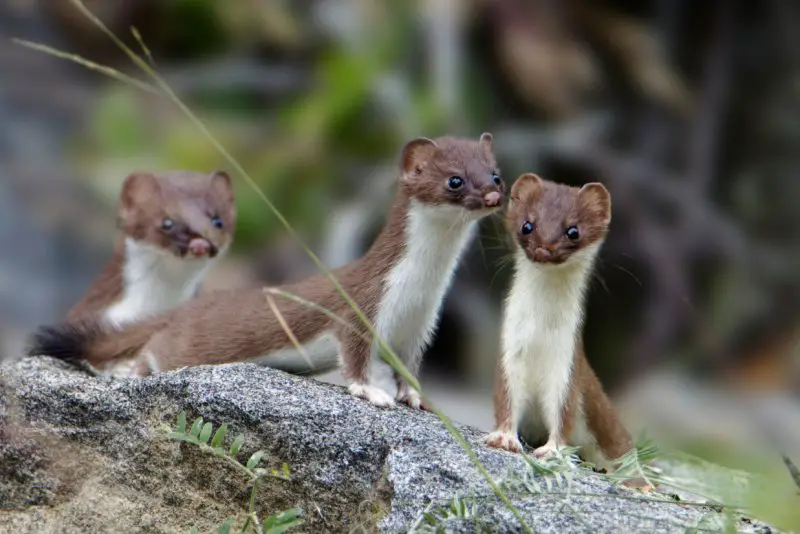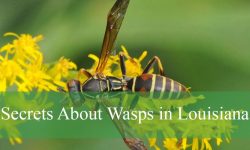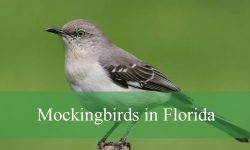Weasels are some of the most fascinating small carnivores found across New York, often recognized by their long, slender bodies, sharp hunting skills, and unique seasonal color changes. Despite their small size, these mammals are efficient predators that play an important role in maintaining ecological balance by controlling rodent populations. Many people in the state catch only brief glimpses of them, as they are elusive and quick, often darting through meadows, woodlands, and wetlands.
In New York, three species of true weasels live in various habitats. These are the long-tailed weasel, the short-tailed weasel (also known as the ermine or stoat), and the least weasel. Each has distinct characteristics that set them apart, although their similarities can make identification tricky for casual observers. Learning how to tell them apart not only helps in wildlife appreciation but also enriches our understanding of New York’s biodiversity.
This article will cover the three types of weasels found in New York in detail, highlighting their characteristics, size, behavior, and preferred habitats. Along the way, we will also touch on their close relatives in the mustelid family, such as mink, fishers, martens, and river otters, which are often confused with true weasels but are not considered weasels in the strict sense.
The Long-Tailed Weasel in New York

Characteristics and Appearance
The long-tailed weasel (Neogale frenata) is the largest weasel species in New York and one of the most widespread. Its body is slender with short legs and a tail that typically makes up about half its body length, hence the name. During the summer months, the fur is rich brown on the back and pale yellowish-white on the underside. In colder northern areas of New York, this weasel undergoes a dramatic seasonal molt, turning white in winter except for the black tip of its tail. This adaptation provides excellent camouflage against snow, making it harder for both predators and prey to spot them.
Size and Identification
Adult long-tailed weasels generally range from 13 to 18 inches in total length, including their distinctive tail. Males are noticeably larger than females, sometimes almost twice the weight. The long black-tipped tail is the most reliable way to identify this species in the field. Unlike the short-tailed weasel, the long-tailed weasel’s tail is proportionally longer and bushier, and unlike the least weasel, it always has that distinctive dark tip. These features make it the easiest of the three New York weasels to recognize if seen clearly.
Behavior and Habitat
Long-tailed weasels are fierce and agile hunters, known for taking down prey larger than themselves, including rabbits and squirrels. They are excellent climbers and swimmers, but most of their hunting is done on the ground, where they chase down mice, voles, and other small mammals. They occupy a variety of habitats across New York, including farmlands, brushy fields, forests, and wetlands. Farmers often view them as beneficial because they reduce rodent numbers, although they may occasionally raid chicken coops. Their adaptability and wide distribution make them the most commonly encountered weasel in the state.
The Short-Tailed Weasel or Ermine in New York

Seasonal Appearance and Coat Changes
The short-tailed weasel (Mustela erminea), also called the ermine or stoat, is smaller and more compact than the long-tailed weasel. In summer, its fur is brown above and whitish below, similar to its relatives. However, in the northern parts of New York, it also turns completely white in winter, except for its black tail tip. The pure white coat is called “ermine,” which was historically prized in the fur trade and even used in royal garments. This seasonal transformation makes the ermine one of the most iconic weasels associated with cold climates.
Size and Distinguishing Features
As its name suggests, the short-tailed weasel has a tail that is proportionally shorter than that of the long-tailed species. Adults typically measure between 7 and 13 inches long, making them smaller overall. The black tip on the tail is still present, which helps distinguish it from the least weasel. If you encounter a small weasel in New York with a black-tipped tail, but the tail is relatively short, it is most likely an ermine. This subtle difference is often the key field mark for separating it from its larger cousin.
Behavior and Ecology
Ermines are quick and energetic predators, feeding mostly on small rodents such as voles, shrews, and mice. They also consume birds, insects, and even amphibians when available. Their hunting style involves entering burrows and tight spaces where larger predators cannot reach. In New York, short-tailed weasels are often associated with wooded areas, brushy habitats, and farmland edges. They are highly territorial and will defend their hunting grounds aggressively. Though elusive, their ecological importance cannot be overstated, as they help regulate small mammal populations that otherwise might reach destructive numbers.
The Least Weasel in New York

Physical Traits and Identification
The least weasel (Mustela nivalis) is the smallest member of the weasel family in New York and the world. Adults usually measure only 6 to 8 inches long, with a very short tail that lacks the black tip seen in the other two species. The absence of a black-tipped tail is the main feature that sets it apart. The body is slender, with brown fur on the back and white on the belly during summer. In colder regions, some individuals may also turn all white in winter, though this is less common than in long-tailed or short-tailed weasels.
Size and Range in New York
Because of their tiny size, least weasels are rarely seen and are considered uncommon in New York. Their small size makes them hard to detect, and many sightings go unreported. They are often overlooked in favor of their larger cousins, but they are indeed present in the state. Least weasels thrive in grasslands, brushy meadows, and open fields where small rodents are abundant. Their diminutive size allows them to chase mice into burrows too narrow for larger predators.
Behavior and Ecological Role
Despite being so small, least weasels are fearless hunters with high metabolisms that require them to eat frequently. They prey almost exclusively on small rodents, which they pursue with remarkable persistence. They can slip into tiny tunnels and crevices, making them one of the most efficient rodent predators in New York’s ecosystems. Their presence, though often unnoticed, plays a crucial role in maintaining balance within small mammal populations. Observing one in the wild is rare, but it is a rewarding experience for naturalists who recognize their ecological significance.
Weasel Relatives in the Mustelid Family
The Wider Mustelid Family in New York
Besides the three true weasel species, New York is also home to several other members of the mustelid family (Mustelidae). These include the American mink (Neogale vison), the fisher (Pekania pennanti), the American marten (Martes americana), and the North American river otter (Lontra canadensis). While they share similar body plans with weasels, including elongated forms and carnivorous diets, they are not classified as true weasels.
Distinguishing Them from True Weasels
Mink are semi-aquatic and are commonly found along rivers, lakes, and wetlands. They are larger and darker than weasels and do not change color in winter. Fishers are much bigger, often mistaken for oversized weasels, and are skilled predators of porcupines. Martens inhabit forested areas, especially in the Adirondacks, and have a more arboreal lifestyle. River otters are the largest of these relatives, fully adapted to aquatic habitats, with webbed feet and playful behavior.
Importance of the Distinction
While people sometimes refer to these animals as weasels, naturalists emphasize the difference. True weasels in New York are limited to the long-tailed, short-tailed, and least weasels. Their larger relatives, though members of the same family, have different lifestyles and ecological niches. Recognizing the distinction helps avoid confusion and deepens our understanding of wildlife diversity in the state.
Conservation and Human Interactions
Historical Perspectives
Historically, weasels and their relatives were heavily trapped for fur. The ermine in particular was valued for its white winter coat, symbolizing luxury and royalty in European history. In New York, fur trapping played a role in the state’s early economy, and although practices have changed, remnants of this history remain in cultural traditions.
Modern Ecological Role
Today, weasels continue to play an important role in controlling rodent populations. Farmers often appreciate their presence because they reduce crop damage caused by mice and voles. At the same time, some conflicts occur when weasels enter chicken coops or game bird pens. Understanding their role in ecosystems helps balance appreciation with management.
Conservation Status in New York
All three species of weasels are still present in New York, although the least weasel is considered uncommon and harder to encounter. Habitat loss and changes in land use may affect their numbers locally, but none of the species are currently listed as endangered in the state. Continued monitoring ensures that these small but vital predators remain part of New York’s natural heritage.
Conclusion
Weasels may be small, but they are among the most fascinating predators found in New York. The state is home to three species of true weasels: the long-tailed weasel, the short-tailed weasel or ermine, and the least weasel. Each has unique features, from the long, black-tipped tail of the long-tailed species to the royal winter coat of the ermine and the tiny, fearless least weasel. Together, they showcase the adaptability and resilience of these remarkable mammals.
It is also important to remember that other mustelids such as mink, fishers, martens, and river otters share New York’s ecosystems but are not classified as weasels in the strict sense. Recognizing these differences enriches our knowledge and helps us better appreciate the diversity of wildlife across the state.
Whether seen darting through fields, slipping along woodland edges, or briefly crossing a snowy path, weasels remain a vital and captivating part of New York’s natural world.
FAQs about Weasels in New York
Are there weasels in New York?
Yes, New York is home to three species of true weasels: the long-tailed weasel, the short-tailed weasel (ermine), and the least weasel. Each species has its own characteristics, habitats, and behaviors, making them important members of the state’s ecosystems.
How can you tell a long-tailed weasel from a short-tailed weasel?
The easiest way is by looking at the tail. The long-tailed weasel has a proportionally longer, bushier tail with a black tip, while the short-tailed weasel has a shorter tail but also retains the black tip. Size can also help, as long-tailed weasels are larger overall.
Do weasels in New York turn white in winter?
Yes, both the long-tailed weasel and the short-tailed weasel undergo a seasonal color change in northern and colder parts of New York, turning white in winter for camouflage. The least weasel may also turn white in some cases, but it is less common.
Are weasels dangerous to humans?
Weasels are not considered dangerous to humans. They are small carnivores that primarily hunt rodents and small animals. However, they may occasionally raid chicken coops or bird pens, which can cause conflicts with farmers or backyard poultry keepers.
What is the smallest weasel in New York?
The least weasel is the smallest, measuring only about 6 to 8 inches long. Unlike the other two species, it has a very short tail with no black tip, making it easy to identify if observed closely.
What other animals in New York are related to weasels?
Besides the three true weasels, New York is also home to mink, fishers, martens, and river otters. These animals belong to the same mustelid family but are not classified as true weasels. They are larger and have different lifestyles, especially the semi-aquatic mink and otter.






